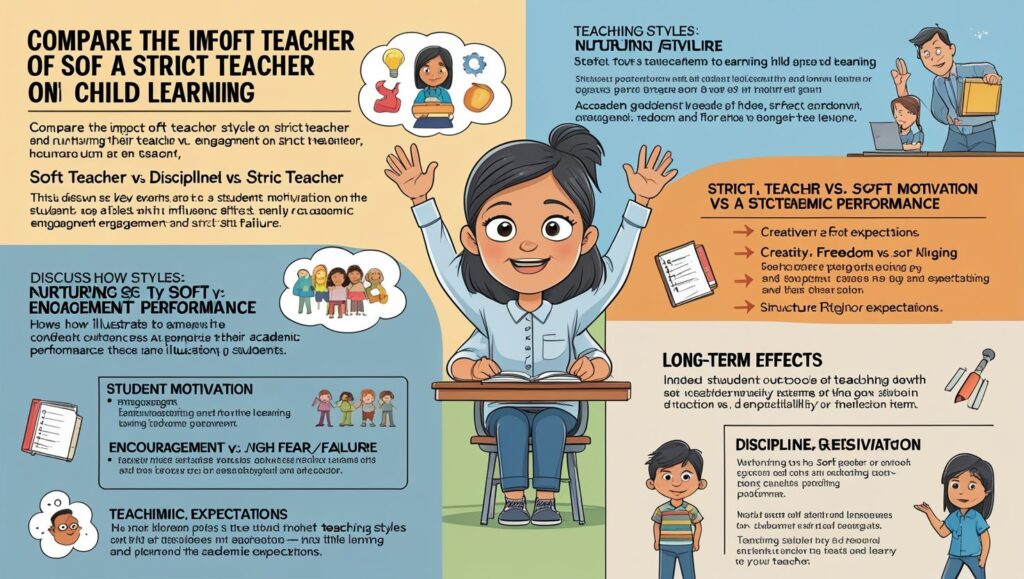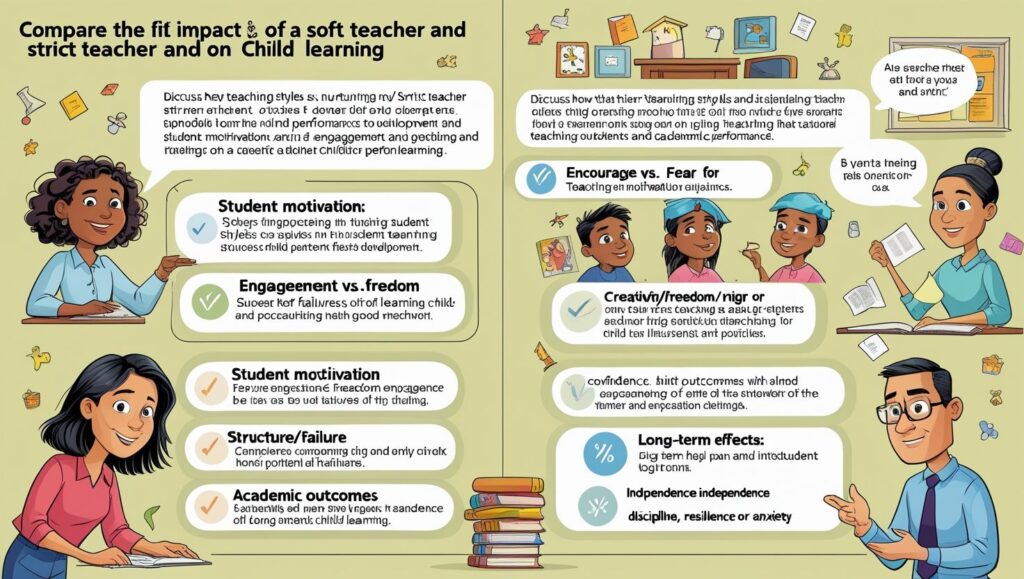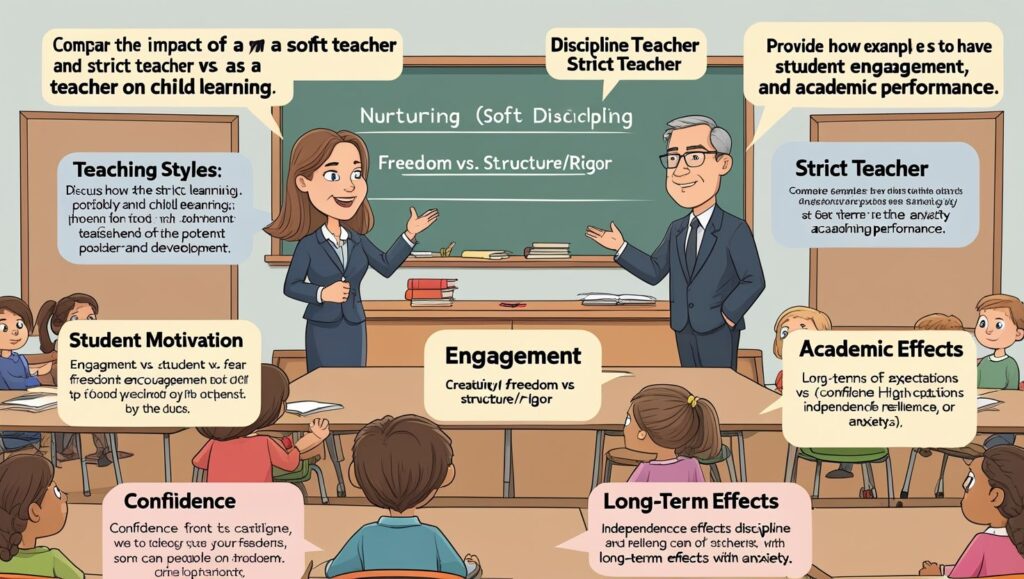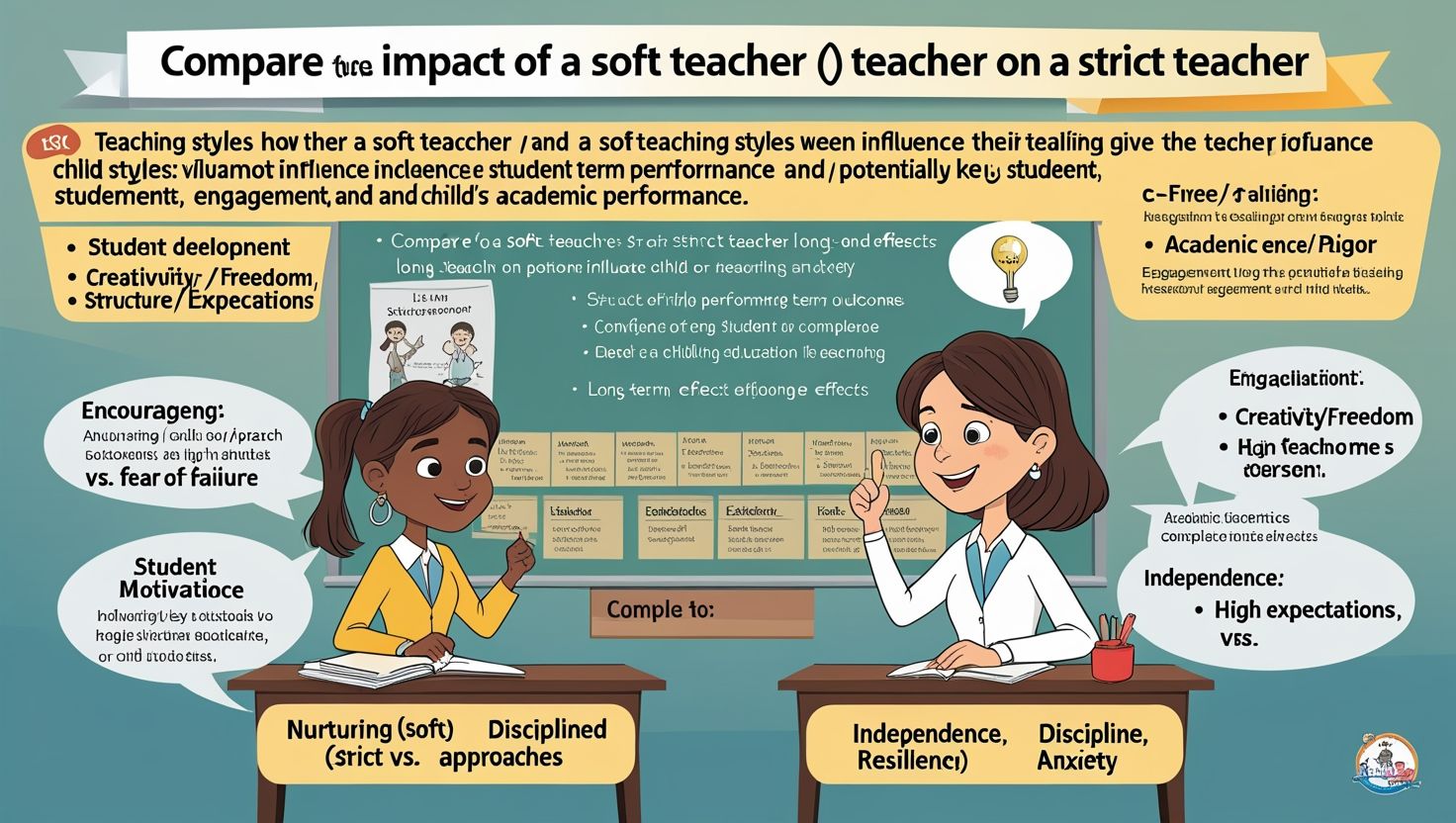Introduction:
Soft Teacher vs. Strict Teacher: Impact on Child Learning, The impact of a teacher’s personality is undeniable in shaping student learning. Certainly, two common teaching styles are soft and strict. Although both aim for student success, their approaches differ significantly. While soft teachers are more compassionate and nurturing, strict teachers tend to emphasize discipline and structure. Consequently, these contrasting styles can influence a child’s academic and emotional development in unique ways. Therefore, it becomes essential to evaluate how each method affects learning outcomes.
Moreover, today’s educational settings are more complex than ever. Because of changing student needs, teachers often adapt their styles to meet diverse learning requirements. In this light, understanding the long-term influence of being soft or strict helps stakeholders make informed decisions. Furthermore, it fosters awareness among educators to strike a balance.
Additionally, every child responds differently. Hence, one style may work wonders for one student and cause anxiety for another. In short, teacher behavior contributes directly to classroom environment, student motivation, and academic achievement. To explore this further, we will analyze various aspects such as emotional well-being, classroom discipline, creativity, confidence, and long-term academic performance under both styles.
Emotional Development under Soft and Strict Teachers
Emotional development is a key component of child learning. A soft teacher, typically warm and supportive, builds emotional security in students. As a result, children feel comfortable expressing their feelings. Consequently, this leads to increased trust and openness in the classroom. In contrast, strict teachers may unintentionally suppress emotional expression due to fear of punishment or criticism.
Furthermore, soft teachers often prioritize emotional well-being along with academics. Because they listen attentively and offer empathy, students feel understood and valued. This emotional backing strengthens student-teacher bonds. On the other hand, strict teachers might focus more on rules and performance. Therefore, students under their guidance may feel less emotionally connected.
Still, a structured and disciplined environment has its own emotional merits. In some cases, it builds resilience and teaches self-control. However, if overdone, it can cause stress, anxiety, or even emotional detachment. Meanwhile, soft teachers may create overly relaxed environments, sometimes leading to overdependence or emotional fragility.
Thus, while both styles affect emotions, the key difference lies in how children process those emotions. Ultimately, emotional development flourishes best in balanced settings where authority and empathy coexist. Hence, finding that balance becomes crucial for nurturing emotionally healthy learners.

Discipline and Behavior Management Approaches
Discipline plays a major role in maintaining effective learning environments. Typically, strict teachers emphasize rules, punctuality, and obedience. Therefore, students under their supervision often follow routines strictly. In this way, order and silence are maintained. However, this rigidity can sometimes create pressure and reduce spontaneous interaction.
In contrast, soft teachers tend to adopt a lenient approach to discipline. Because they rely on reasoning and dialogue, students feel heard and less threatened. As a result, classroom management becomes democratic rather than authoritarian. Nevertheless, if boundaries are unclear, students might misuse this freedom.
Furthermore, strict discipline can enhance classroom focus. Since students fear consequences, they remain attentive. Still, excessive control may stifle creativity and reduce confidence. Conversely, soft approaches can foster cooperation and mutual respect. Yet, without clear rules, classroom disruptions may increase.
Additionally, behavior problems are handled differently. Strict teachers might use penalties or detentions, whereas soft teachers prefer counseling and conflict resolution. Each method has strengths, but overuse of either can lead to imbalance.
Thus, effective discipline lies not in extremity but in consistency. Whether soft or strict, teachers must ensure fairness and clarity in rules. Ultimately, well-managed behavior builds safe spaces where students can thrive academically and socially.
Motivation and Student Engagement
Motivation is a driver of successful learning. A soft teacher often uses encouragement, praise, and personal attention. As a result, students feel valued and motivated to try harder. Moreover, they develop a love for learning without the fear of failure. This positive reinforcement boosts engagement.
On the other hand, strict teachers usually set high expectations. Because they demand excellence, students may push themselves harder. However, the motivation here stems from external pressure. While this may increase academic output, it may reduce internal motivation.
Furthermore, soft teachers celebrate small efforts. Therefore, even average performers stay engaged. In contrast, strict teachers focus on outcomes. Thus, slow learners may feel left behind or demotivated. Although pressure can lead to results, it can also cause burnout or loss of interest.
Additionally, soft teachers create interactive learning spaces. They use games, group work, and discussions to maintain student involvement. Strict teachers, meanwhile, might prioritize lectures, worksheets, and drills. While these are effective in exams, they may limit long-term curiosity.
Hence, both styles have merits. But when motivation is nurtured intrinsically, students perform better in the long run. Therefore, a mix of high expectations and emotional support ensures sustained motivation and active engagement.

Confidence and Self-Esteem Building
Confidence is a cornerstone of academic success. Soft teachers often help students believe in themselves. Through kind words and gentle correction, they build a child’s self-esteem. As a result, students feel free to participate without fear of being wrong. This confidence translates into better performance.
Strict teachers, however, may focus more on flaws. Because they expect perfection, even small errors are highlighted. While this sharpens skills, it may hurt a child’s confidence. Still, in some students, overcoming tough expectations may boost self-esteem.
Moreover, soft teachers tend to appreciate individual differences. They understand that every student progresses at their own pace. Consequently, struggling learners feel included. On the contrary, strict teachers may use comparison as a tool. Although this motivates some, it embarrasses others.
Furthermore, soft teachers often involve students in decisions. They seek opinions and validate their ideas. This collaborative approach enhances a student’s self-worth. In contrast, strict teachers control most classroom choices. This top-down method may limit student voice.
Therefore, the development of confidence requires a careful blend of support and challenge. Soft teachers excel in emotional empowerment, while strict ones sharpen discipline. Ideally, when both are balanced, students develop resilient confidence and healthy self-esteem.
Creativity and Critical Thinking
Creativity thrives in open environments. A soft teacher generally encourages out-of-the-box thinking. Because they accept diverse viewpoints, students are free to explore new ideas. Consequently, learners develop creativity and critical thinking. Activities such as brainstorming, storytelling, and role-play are often used.
In contrast, strict teachers usually follow structured syllabi. Because they emphasize correct answers, students focus more on memorization than exploration. Although this helps in standardized testing, it may restrict creativity. Still, structured methods can build logical thinking and analytical skills.
Furthermore, soft teachers permit students to take academic risks. As a result, learners experiment and innovate. Even if they fail, they learn from mistakes. Strict teachers, however, discourage deviation from instruction. Thus, students might fear experimentation.
Also, creative thinking is linked with emotional freedom. Soft teachers build this by reducing pressure. On the other hand, strict classrooms may create anxiety, limiting creative performance. However, some strict educators include creativity within rigid frames, combining structure and innovation.
Ultimately, fostering creativity requires trust, freedom, and encouragement. While soft styles allow flexibility, strict methods can provide direction. Therefore, the best approach includes both—offering freedom within structured learning boundaries to cultivate creative and critical minds.
Academic Achievement and Performance
Academic success is often the main goal of schooling. Strict teachers generally produce high achievers in exams. Because they emphasize practice, revision, and discipline, students perform well in structured assessments. Moreover, their insistence on perfection leads to mastery of content.
However, soft teachers also contribute significantly to academic growth. Through personalized attention and encouragement, they help even weaker students progress. Although they may not stress performance, their nurturing approach ensures learning without fear. Consequently, students develop conceptual clarity.
Furthermore, strict teachers frequently use tests, homework, and deadlines. This builds consistency and time management. Yet, it may also cause academic stress. Soft teachers, in contrast, focus on learning processes. They allow flexible timelines and encourage curiosity. While this relaxes students, it may reduce competitiveness.
Also, different students respond to different styles. High achievers may excel under pressure, while average students may need emotional support. Therefore, a uniform teaching style cannot serve all.
In short, academic success results from a balance of structure and support. Strictness drives performance, while softness fosters understanding. When both are integrated, students not only score high but also retain knowledge and develop problem-solving skills.

Classroom Environment and Peer Relationships
The classroom environment significantly affects learning. Soft teachers usually create warm and inclusive settings. Because they promote respect and cooperation, students form strong peer bonds. Group work and peer learning are commonly encouraged. As a result, the classroom becomes a supportive learning community.
In contrast, strict teachers may enforce silence and order. Although this reduces noise and distraction, it limits social interaction. Consequently, peer relationships might remain formal. Still, structured environments prevent bullying and maintain discipline.
Furthermore, soft classrooms often have open seating plans and relaxed rules. This comfort boosts participation and creativity. However, too much leniency can lead to chaos. Strict classrooms are highly organized. Therefore, students know their roles and follow routines. But, overly rigid setups may feel suffocating.
Additionally, under soft teachers, students are more likely to share ideas and ask questions. This encourages collaboration. Under strict teachers, discussions may be limited, as students wait for permission to speak. This can reduce spontaneous peer learning.
Thus, the ideal classroom blends comfort with control. A peaceful environment with mutual respect ensures not only academic success but also emotional safety. Both teaching styles contribute differently, but a balanced approach enhances peer interaction and a positive learning space.
Long-Term Impact on Learning Attitude
Teaching styles have lasting effects on learning attitudes. Soft teachers, through their empathy and encouragement, nurture lifelong learners. Because students associate learning with joy, they remain curious even outside the classroom. Over time, this promotes independent thinking and self-motivation.
In contrast, strict teachers instill discipline and work ethic. Their students often develop strong organizational habits and goal orientation. Even years later, they remember the structure and dedication taught in class. However, if the environment was fear-based, they may also carry anxiety or resistance toward learning.
Moreover, soft approaches develop emotional intelligence. Students learn to manage feelings, resolve conflicts, and support peers. Strict teaching, on the other hand, sharpens focus and resilience. These traits are useful in competitive environments.
Furthermore, how students recall their classroom experience influences their future. A positive memory creates enthusiasm for learning. A negative one may lead to detachment. Therefore, teachers must be mindful of the emotional and psychological footprints they leave.
Ultimately, long-term learning depends on both emotional connection and intellectual challenge. By integrating the warmth of soft teaching with the discipline of strict teaching, educators can shape students who are not only academically strong but also emotionally intelligent and lifelong learners.
Conclusion: Striking the Right Balance
Clearly, both soft and strict teachers leave a profound mark on a child’s educational journey. Soft teachers nurture, support, and encourage emotional growth. Strict teachers guide, discipline, and push for excellence. Although both styles differ greatly, each holds value in its own way. Therefore, neither is wholly better nor worse.
Moreover, children are diverse. What works for one may not suit another. As such, flexibility is key. Educators must assess the needs of their students and adapt accordingly. Combining warmth with structure can yield the best outcomes. A balanced teacher maintains control without compromising compassion.
Furthermore, parents and school administrators play vital roles. They must support teachers in adopting balanced approaches and provide training if necessary. Ultimately, successful education hinges on cooperation between teacher personality, student needs, and institutional support.
In conclusion, the ideal teaching style is not a choice between soft or strict. Rather, it is a smart blend of both—where expectations are high, but support is higher. Only then can we foster confident, motivated, and high-achieving learners who carry the joy of learning throughout life.

Cappadocia sunrise balloon flight Aisha M. ★★★★★ Cultural immersion exceeded expectations! Learned pottery in Avanos using ancient techniques, then dined with a local family. Unforgettable! https://fcschalke04fansclub.com/read-blog/10027
esb7do
This post gave me a new perspective I hadn’t considered.
You’ve done a great job with this. I ended up learning something new without even realizing it—very smooth writing!
Keep writing! Your content is always so helpful.
Such a simple yet powerful message. Thanks for this.
This made me rethink some of my assumptions. Really valuable post.
Your tips are practical and easy to apply. Thanks a lot!
This topic really needed to be talked about. Thank you.
I appreciate the depth and clarity of this post.
This content is gold. Thank you so much!
Thanks for addressing this topic—it’s so important.
GO88 là cổng game bài đổi thưởng uy tín với bố cục tân tiến, đồ họa siêu thực và bảo mật kiên cố. Người chơi tự tin thử sức đa dạng game bài thú vị như Tiến Lên, Phỏm, Xóc Đĩa, Tài Xỉu. Đăng ký ngay GO88 để thỏa sức hệ thống nạp rút chớp nhoáng, hỗ trợ 24/7 và nhận ưu đãi siêu to mỗi ngày.
Great post! I’m going to share this with a friend.
This helped clarify a lot of questions I had.
This post cleared up so many questions for me.
Your breakdown of the topic is so well thought out.
You’re doing a fantastic job with this blog.
This gave me a lot to think about. Thanks for sharing.
You always deliver high-quality information. Thanks again!
Thanks for addressing this topic—it’s so important.
I love the clarity in your writing.
I love how clearly you explained everything. Thanks for this.
This made me rethink some of my assumptions. Really valuable post.
I like how you presented both sides of the argument fairly.
This was incredibly useful and well written.
Your passion for the topic really shines through.
Thanks for taking the time to break this down step-by-step.
This content is gold. Thank you so much!
This was really well done. I can tell a lot of thought went into making it clear and user-friendly. Keep up the good work!
I enjoyed every paragraph. Thank you for this.
This gave me a whole new perspective on something I thought I already understood. Great explanation and flow!
What an engaging read! You kept me hooked from start to finish.
Very useful tips! I’m excited to implement them soon.
I love how clearly you explained everything. Thanks for this.
Your breakdown of the topic is so well thought out.
What an engaging read! You kept me hooked from start to finish.
This was incredibly useful and well written.
You bring a fresh voice to a well-covered topic.
You write with so much clarity and confidence. Impressive!
What an engaging read! You kept me hooked from start to finish.
This is exactly the kind of content I’ve been searching for.
Your articles always leave me thinking.
Your passion for the topic really shines through.
The way you write feels personal and authentic.
You have a real gift for explaining things.
f2apyp
haul4p
oa97cj
I’m now not sure where you are getting your info, but good topic. I must spend some time studying more or working out more. Thank you for fantastic info I used to be searching for this info for my mission.
Thiis is very interesting, You’re a very skilledd blogger.
I’ve joined your feed and look forwsard to seeking more of you wonderful post.
Also, I have shared your site in my social networks! https://hot-fruits-glassi.Blogspot.com/2025/08/hot-fruitsslot.html
I’m impressed, I must say. Actually hardly ever do I encounter a weblog that’s each educative and entertaining, and let me inform you, you could have hit the nail on the head. Your idea is excellent; the issue is one thing that not enough individuals are speaking intelligently about. I’m very happy that I stumbled across this in my seek for something regarding this.
I’ve read some good stuff here. Certainly price bookmarking for revisiting. I wonder how much attempt you set to make this sort of magnificent informative web site.